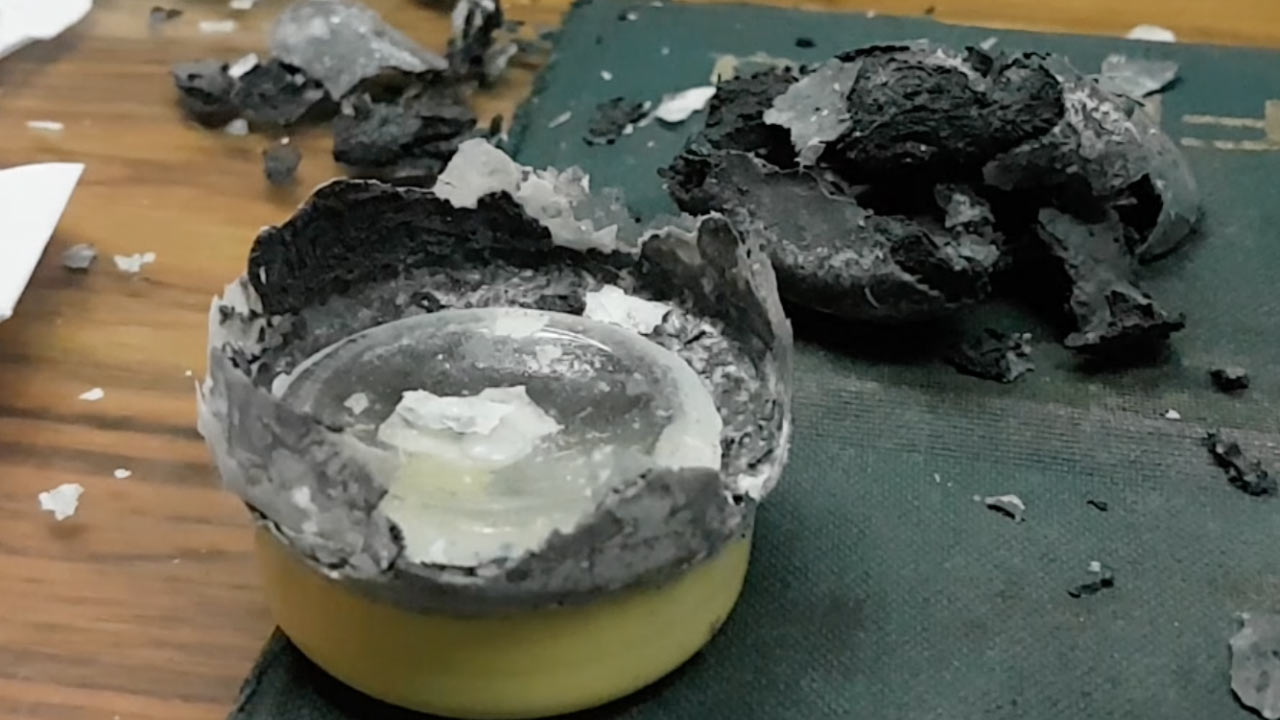ECCO - Testing for 'strange radiation'
Before giving us a large sample of ECCO 'fuel', Suhas Ralkar wanted to warn us about a curious property it has, it likes to destroy the Polyethylene (PET) bottle he was about to supply it in. He took another sample from the shelf and held it aloft and just with a slight pressure from his fingers, the whole thing exploded!

Here is a video taken at the time
Strange radiation
Could this degredation of the polymer not come simply from a chemical process, but additionally from the prior influence of strange radiation?
We appear to have observed tracks that look like strange radiation, which was reported here.
Indeed, there are links in that previous article where other scientists have used a polymer, called CR-39, to detect the strange radiation.
In the radiation detection application, CR-39 is used as a Solid-State Nuclear Track Detector to detect the presence of ionising radiation. Energetic particles colliding with the polymer structure leave a trail of broken chemical bonds within the CR-39. When immersed in a concentrated alkali solution (typically sodium hydroxide) hydroxide ions attack and break the polymer structure, etching away the bulk of the plastic at a nominally fixed rate. However, along the paths of damage left by charged particle interaction the concentration of radiation damage allows the chemical agent to attack the polymer more rapidly than it does in the bulk, revealing the paths of the charged particle ion tracks. The resulting etched plastic therefore contains a permanent record of not only the location of the radiation on the plastic but also gives spectroscopic information about the source. Principally used for the detection of alpha radiation emitting radionuclides (especially radon gas), the radiation-sensitivity properties of CR39 are also used for proton and neutron dosimetry and historically cosmic ray investigations. SOURCE
What could be happening therefore, is that the strange radiation is making the PET chemical bonds break down a little, therefore making it vulnerable to etching by the Potassium Hydroxide.
The experiment
So, the experiment would start with exposing PET to the 'strange radiation' from the fuel without making direct contact with it and then immersing that exposed PET, into Potassium Hydroxide to see if there is any etching effects.
Some PET taken from the same bottle but not exposed to the fuel, in any way, would be used as a control.

Update 1
Amongst other things, in this video, preventing exposure to UV radiation and deliberately adding it is discussed, also ways to test if any potential 'strange radiation' or its effects can be guided. Updates have been made including some in response to recent requests by contributor Martijn Lammers and historical comments by 'Axil Axil'.
Update 2
First thermal neutron, continued degradation of the sample bottle.
Strange Radiation update 3 - 1 Week
Degradation in more than just the fuel bottle?
Thanks to Max Nozin who found this Italian research from earlier this year that observed Neutrons (and no gamma) due to pulsed sound stimulation.
http://www.claudiopace.it/wp-content/uploads/2017/06/4_page_paper_Petrucci.pdf
They used CR39 for detection.
UV radiation is a common cause for polymer degradation as well as heat. Perhaps a bit of both in this case.
Well, not sure how much UV radiation it can get in the middle of clothes in a thick bag.
It is a good point though, this large metal cover will be added...
That's really strange, thanks for sharing!
oh - you're good!
😉😎
Oh my dear, curiouser and curiouser...
Strange Radiation Update 4 - 3+Weeks
Further degredation
What I think is happening to produce the deterioration of the plastic bottle containing the ECCO fuel is nuclear reactions produced by the nuclear active agents residing in the ECCO fuel. This agent can then move forward to penetrate the plastic and react with the plastic in the second plastic container. and then pass through that second barrier and react with the seal of the neutron detector tube.
Georges Lochak and Leonid Urutskoev attempted to characterize this agent and found that the agent passed through aluminum but would not pass through iron, a magnetic material.
MFMP can use the deterioration of the plastic bottle as an experimental probe to see what materials this agent will pass through and which materials will contain it.
John Fisher found that this agent was constrained inside a rubber seal in his experimental setup and the activated seal produced tracks in CR39 detector. He also saw CR39 tracts in the steam coming out of a electrolysis experiment presumably produced by the LENR active agent.